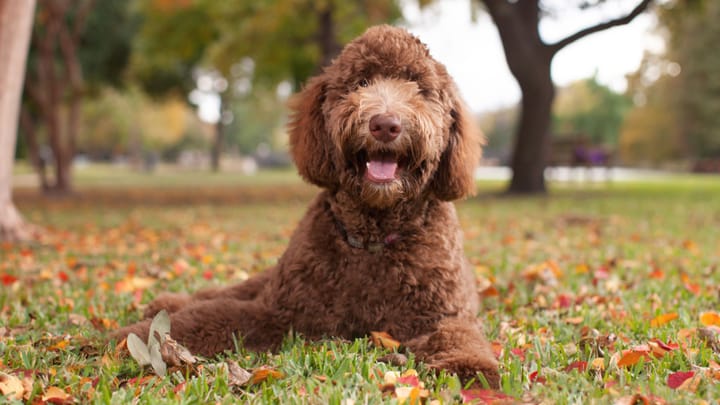Labradoodle
Other name: Labrapoodle


The Labradoodle is a cross between a Labrador and a Poodle. Labradoodles are the world's most popular dog crossbreed. They are not actually recognised as an official breed, and for good reason! As a cross-breed or “designer dog”, it's difficult to determine what Labradoodles will look like or how they will behave, and there simply isn't enough consistency to create a breed standard.
The Labrador Retriever is one of the most popular breeds in the world, mainly due to its remarkable friendliness, enthusiasm towards all challenges, and its very playful and cheerful personality. Docile, gentle and intelligent, Labradors are used as service dogs, search and rescue dogs, hunting dogs, and of course, as loving pets! They can adapt to all kinds of lifestyles and excel in various canine disciplines.
The Poodle comes in four sizes (toy, miniature, medium and standard) and five different coat colours (black, white, grey, brown or apricot). They are very intelligent dogs who, despite their misleadingly fragile appearance, are actually very robust and resilient. Cheerful, playful, lovable and affectionate, Poodles can adapt to many different lifestyles.

Labrador
The Labrador Retriever is one of the most popular breeds in the world, mainly due to its remarkable friendliness, enthusiasm towards all challenges, and its very playful and cheerful personality. Docile, gentle and intelligent, Labradors are used as service dogs, search and rescue dogs, hunting dogs, and of course, as loving pets! They can adapt to all kinds of lifestyles and excel in various canine disciplines.

Poodle
The Poodle comes in four sizes (toy, miniature, medium and standard) and five different coat colours (black, white, grey, brown or apricot). They are very intelligent dogs who, despite their misleadingly fragile appearance, are actually very robust and resilient. Cheerful, playful, lovable and affectionate, Poodles can adapt to many different lifestyles.
|
Life expectancy |
The Labradoodle has a life expectancy of between 12 and 15 years |
|
Temperament |
|
|
Size |
Medium
|
|
Adult size |
Female
Between 14 and 24 in
Male
Between 14 and 24 in
|
|
Adult weight |
Female
Between 15 and 64 lb
Male
Between 15 and 64 lb
|
|
Coat colour
|
Black White Brown Red Sand |
|
Type of coat
|
Long Wavy |
|
Eye colour
|
Brown
|
|
Purchase price |
The Labradoodle costs between £1500 and £3500 |
More details about the Labradoodle
Labradoodle: Origins and history
Although crosses between Labradors and Poodles have existed for around 100 years, it wasn't until the 1980s that the term “Labradoodle” was coined by Wally Conron, an Australian breeder in charge of the breeding program for the Royal Guide Dog Association of Australia.
Mr. Conron was a guide dog trainer and was looking to create a guide dog for a visually impaired person whose husband was allergic to dog hair. As Poodles are hypoallergenic, he decided to cross one with a Labrador to combine the best of both breeds, and the Labradoodle was born! This makes the Labradoodle an ideal dog for people with dog allergies.
Labradoodle: Characteristics
Labradoodle: Behaviour
Training a Labradoodle
Labradoodles are highly intelligent and eager to please, so they can learn just about anything. But, like any highly intelligent, active dog, they need an owner who's up to the task. A poorly trained Labradoodle can become boisterous and difficult to manage. Training must start early and be taken very seriously, with particular emphasis on teaching the dog impulse control. As Labradoodles are very people-oriented, you'll only get good results by using positive reinforcement. Punishment or negative reinforcement can be detrimental to the training process.
Labradoodle: Lifestyle
Breed compatibility Labradoodle
Labradoodle: Shedding
Average
If your dog's coat resembles that of a Labrador, expect a lot of shedding. Although the coat is relatively short, you should brush it at least once a week to keep it clean, shiny and free of tangles and knots. During seasonal moulting in spring and autumn, you should brush your dog's coat every day.
If your dog's coat resembles that of a Poodle, there's a good chance they won't shed. Instead, their coat will grow continuously, meaning a trim every few weeks will be necessary if you don't want your Doodle to look like a sheep. This means regular visits to the groomer, so future owners need to prepare for a significant financial investment!
Labradoodle: Grooming
Labradoodles are demanding dogs when it comes to grooming, whatever type of coat you get.
Labradoodle: Health
The Labradoodle is a sturdy, healthy dog.
The coat type of the Labradoodle can vary greatly, depending on what they inherit from the parent breeds. Some coat types may help them withstand heat better than others, but as with all breeds, it is important to take precautions in hot weather.
Some Labradoodles inherit the dense, curly coat of the Poodle, which may make them better adapted to cold climates. However, Labradoodles with coats more similar to those of the Labrador may be less suited to intense cold. In any case, it's important to protect dogs from any kind of extreme weather conditions.
Labradoodles often have a big appetite and, if left to their own devices, tend to overeat and put on weight. It's therefore important to pay particular attention to their diet and to monitor their weight regularly.
As with any breed or crossbreed, Labradoodles can suffer from a variety of genetic health problems.
If you have a standard-sized Labradoodle, your dog could face hip and elbow dysplasia later in life. The best way to avoid this is to make sure your dog receives the right nutrition and exercise throughout its life. Equally, finding a reputable breeder who takes good care of their dogs' health goes a long way to ensuring your dog is healthy. Progressive retinal atrophy is also a common condition in Labradoodles, so be sure to discuss this with your breeder.






